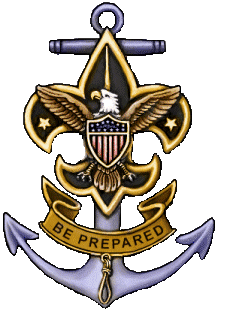Sea Scout Knotting
Requirements

I have been asked if some of my animations can
be used to illustrate requirements for Sea Scouting. For those
who don't know, Sea Scouting is a branch of Boy Scouting which
defines it's purpose as:
Sea Scouting is
organized to promote better citizenship and to improve members'
boating skills and knowledge through instruction and practice
in water safety, boating skills, outdoor, social, and service
experiences, and knowledge of our maritime heritage.
Sea Scouting is a part of the Venturing
program, with units organized as "ships" and specific sea and
ship related requirements for advancement. For more
information, I suggest looking at the Sea Scouting Web Site
The knotting requirements, with illustrations
I've developed for them so far, are listed below. In addition,
I've added a few comments of my own.
Note that this
is not an official site of the Boy Scouts of America, and any
information or opinions expressed here are not necessarily
endorsed by them.
- Apprentice,
Requirement 5
- Seamanship: Using both large and small line, tie and
explain the use of the following knots:
square knot,
bowline,
clove hitch,
sheet bend,
two half hitches,
figure-of-eight, and
cleat hitch. Demonstrate the ability to use a heaving
line.
My Comments: It's interesting that this list so
closely parallels my list of eight basic knots. The changes
are the elimination of the sheepshank (justifiably, I
think) and the Timber Hitch, which comes in under the
"Ordinary" requirements. Additions are the Figure 8, which
I think the scouts should emphasize more, and the Cleat
Hitch, appropriate for Sea Scouting!
- Ordinary, Requirement 7
- Using line appropriate to the craft you
normally use, tie the following knots and explain the use
of each:
overhand knot,
stevedore's knot,
bowline on a bight,
timber hitch,
rolling hitch,
marline hitch,
midshipman's hitch, and
double bowline (French bowline).
My Comments: This is an interesting set. The French
Bowline is what I have elsewhere called a Portuguese
Bowline, and the Rolling Hitch is tied to a pole, though
others use that name for what scouts call a Tautline Hitch.
I still can't understand why an overhand knot is a
requirement for Sea Scouting - hopefully most of them can
already tie their shoes, and have therefore mastered
this.
The most interesting problem was the Midshipman's Hitch. A
search turned up no less that four knots with this name. It
was used to reference a Tautline, a method of attaching a
line to a hook, a particularly ugly knot like two half
hitches, where the second hitch loops around the standing
part twice, and the knot shown here, much like a tautline.
This agrees with Ashley's nomenclature, as well as several
other books I referenced.
- Ordinary Elective 18f
- Ornamental Ropework: Demonstrate your ability to
make a three-strand turk's head
and a three-stand monkey's fist. Use the monkey's fist to
make up a heaving line.
My Comments: The term "three strand Turk's Head" is
ambiguous, but I assume it means the normal 3 Lead by 4
Bight TH
- Able, Requirement 7
- Marlinspike Seamanship: Submit an eye splice, short
splice, and a palm-and-needle whipping. Know the names and
functions of lines used to secure a vessel to a dock.
Understand and execute docking commands used in handling
lines on your ship's main vessel. Describe the parts of a
block and how blocks are sized. Demonstrate the various
types of tackle used by your ship.
Able Elective 17h- Ornamental Ropework: Demonstrate your ability to
fashion the following items of ornamental ropework:
four-strand turk's head, coach whipping, cockscombing,
round braid, flat sennit braid, wall knot, and crown knot.
Make a useful item such as a bos'n's call lanyard, rigging
knife lanyard, bell rope, etc., or decorate some portion of
your ship's equipment such as a stanchion, rail, lifeline,
tiller, etc., as an example of your work.
My Comments: The term "four strand Turk's Head" is
ambiguous, the requirements don't mention the type of
Turk's Head. For the electives, though, this may be a good
thing - allowing the scouts to explore various ornamental
techniques.
If you reached this page from a link
or search, you may get to my entire knotting site here.
| Last updated 6 January 2006. |
© 2002-2006 Alan L. Folsom,
Jr. |
